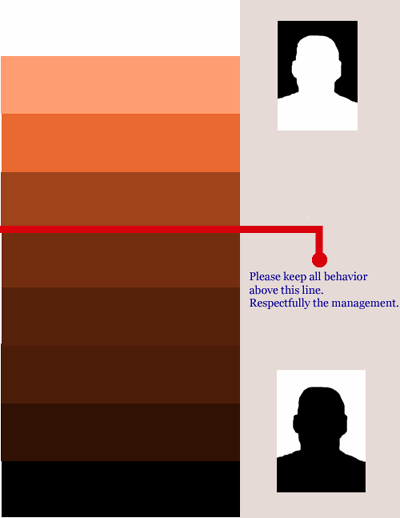The Behavioral Color Chart

When approaching the idea of how to behave professionally here in the US there are some basic things we should know about professionalism. As professionals we should be knowledgeable and educated about the field we seek employment in. Each profession has the power of inclusion or exclusion regarding who will be marked part of that profession and who won't. According to some experts there should be vocabulary identified with a specific profession which might not be known to those outside that profession. This is basic information pulled right out of Wikipedia the stuff we all know and talk about openly.
There are also parts we don't discuss openly. To get to one such aspect of the American workplace let's look at some facts. Our society is still very white male dominated with institutions and traditions passed down through generations of white men going back to Europe. White culture has been shaped by the same white men. Our places of business and public institutions operate on a framework of traditions and mechanisms wholly rooted in the dominant culture of our nation. This platform brought us from a small group of rebellious colonies to the worlds most powerful nation. There is much to be proud of.
Let's get back to that area of our workplace not usually discussed. I'm speaking of how a more pliant definition of professionalism can sometimes work against people from certain ethnic and racial backgrounds. In our larger society there are ways of speaking and behaving often described as either white or black. Just as white Americans have a way of speaking and pronouncing the English language unique to their culture so do black Americans. Black Americans have their own unique culture within the larger American culture. This goes for other ethnic groups as well, but I will use black culture as an example because it is the one most often discussed.
In the work place to speak in a manner considered "too black" is usually frowned upon. This behavior can lead to a number of negative consequences from subtle ridicule to isolation and even harassment. It can effect the level of acceptance among one's coworkers and superiors. Most workplaces especially in areas considered professional are dominated by white American workers, thus it is inevitable that people in a position to help facilitate advancement will on average be white. If you are looked at as too black it can be a death sentence for you in your place of employment. The system is already in place and operating. A reasonable expectation of compliance with what is considered the norm to help facilitate expediency and a smooth running environment is to be expected.
If a person is sufficiently trained to do his or her job, performs their duty correctly, is polite, helpful and productive as a member of a team does that qualify them as a professional? If so how is it a person can be perceived as being too black even though they meet all the standards of their white coworkers? The only difference here is they were raised in a different culture? If work performance is what counts it only follows a high functioning worker regardless of cultural background will excel in todays workplace.
Of course the real world is more complex than that. People will behave as humans both inside and outside the workplace. Doing the job correctly is not the only criteria for being considered up to snuff. Too often the level to which one can "be white" is an additional criteria for job performance - although never openly discussed. One way it might be subtly referred to is by use of the term "not fitting in." A person might also be described as speaking in a "non-professional" manner.
In a Washington Post article entitled "The Price of Acting White" Richard Morin says "acting white is a pejorative term used to describe(blacks) who engage in behaviors viewed as characteristic of whites, such as making good grades, reading books or having an interest in the fine arts." I'm half white myself and was raised in a predominantly white neighborhood and can state for a fact white people often think the same way. However the term is used positively when attributed to non-caucasians acting more white than black. This of course is somewhat natural as it is easier to relate to someone who behaves as oneself.
As relates to the workplace what exactly is the standard for acting in a manner considered white or considered too black outside of some stereotyped SNL skit? Where exactly is the line? It might seem silly to ponder such a question, but people file complaints and lawsuits in the workplace all the time for being discriminated against citing comments on their cultural identity as signifiers of prejudice.
If we admit behavior identified as white is preferred in the workplace we can pinpoint what we feel is behaving too black. Then we can identify why we feel that way. Perhaps then we can loosen up about our fears and prejudices toward one another. We can grasp the idea that behavior of successful Americans comes in many shades and colors. Or maybe it's time to go the other way. We'll put up charts at the employees entrances of jobs across America with the color white on top and various shades of brown working its way down to the color black at the bottom. We'll call them Behavioral Color Charts. The charts will have a little line somewhere that stands out boldly so no mistakes can be made. This will help to identify for all those concerned what is black enough and what exactly is enough black.
Oy.
To read about my personal experiences with harassment click here.
Get Involved
If you'd like to help with maintaining or developing the website, contact us.
Publish
Publish your stories and upcoming events on Indybay.


